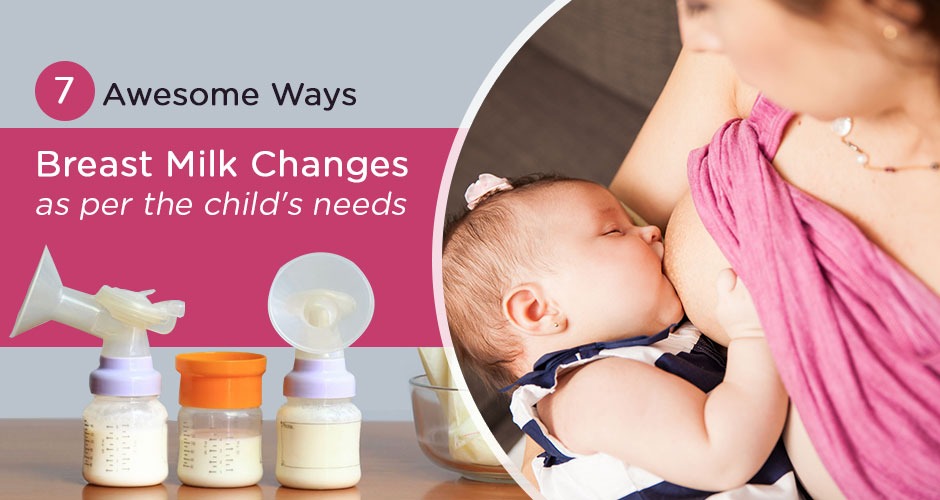
7 Awesome Ways Breast milk Changes as per the child's needs
Breast milk has amazing benefits. It not only boosts the immunity of your baby, but it also contains antibodies that help the baby fight viruses and bacteria and reduces the risk of asthma and allergies. Babies who exclusively breastfeed for the first six months have fewer ear infections and very few bouts of diarrhoea. The World Health Organisation (WHO) recommends exclusive breastfeeding for up to 6 months of age and continued breastfeeding for up to 2 years or beyond, as long as the mother and baby desire. Did you know that breast milk changes according to the growing child’s needs and requirements? Here are a few ways in which breastmilk transforms itself to provide maximum benefits for your little one: Also Read: How to effectively treat swollen breasts in 10 simple ways
1. The first feed and the changes thereafter
The first feed or the colostrum is the most important yellowish-orange fluid that your baby receives. It is full of proteins and immunity boosting antibodies. This is very important for your baby’s growth and as the baby continues to feed, it regulates the production of milk production. For the next 3 to 7 days there will be an increase in the volume of breastmilk. This is called transitional milk and after a duration of 2-3 weeks, this milk transforms into mature milk that your baby will feed on for the next one year.2. The toddler years
As your baby grows older and is introduced to solid foods and other forms of liquids, the production of breast milk decreases. Many moms tend to stop breastfeeding because they think that their babies are getting all the requirements from other sources. However, it is recommended that a child is breastfed till 2 years or beyond to provide them with more antibodies and higher fat content.3. Senses if baby is illness
The breast milk that the baby feeds on sends a message to the body that the baby is ill. So, the body produces ‘supermilk’. This milk has illness specific antibodies and the milk production also increases. When the baby is feeding, the saliva from the baby sneaks into the nipples which warns the mother’s body about the baby’s health. What if the mother is ill? Every breastfeeding mother has at least once been to told to not feed her baby when she is sick. It is important to remember that your milk will not transfer your illness to the baby, until and unless there is an extremely serious illness and your doctor advises you not to. Your milk will produce antibodies that will prevent your baby from getting sick.
4. Changes during growth spurts
During a growth spurt, a baby may transform from feeding 8 times a day to 12 to 14 times a day! Such days are known as frequency days. Breastfeeding moms are often confused when they see their child who was getting a hearty dosage of sleep and feeding properly become restless all of a sudden. The quantity of breast milk increases when a baby is going through a growth spurt.Frequently feeding your baby will help in increasing the fat content in the milk which in turn will provide your baby with the required nutrients and the energy. Also Read: A step by step guide on breastfeeding for new moms5. Changes from day to night
Breast milk changes throughout the day. You may feel that during the early hours of the day, your breasts feel heavier and there is more milk production. When a baby wakes up and is fed breast milk, it keeps him/her awake and energetic. Milk produced in the evening contains elements which help babies relax and get a good night’s sleep. Breast milk has day-specific elements that stimulates activity and has night-specific elements that stimulate rest and sleep. Some doctors are of the opinion that it isn’t wise to express milk and save it for a later.6. Changes during feeding
If you are breastfeeding or have breastfed, you should already have a fair idea about what foremilk and hindmilk is. Foremilk is the milk that comes at the beginning of the feed. The consistency is thin and watery. Hindmilk is the milk that comes when a feed is almost ending. It is thicker in comparison to foremilk. So, while the baby is feeding, breast milk is constantly changing as well. The fat content gradually increases as the baby feeds on it.7. Different flavours of breast milk
Did you know that the food you eat changes the flavour of your breast milk too? Breast milk can come in different flavours like menthol, banana, carrots, fennel, garlic and salt etc. Whether the flavour of breast milk changes entirely after consuming certain types of foods is still an ongoing debate. Let’s just say that if you have had an ice cream and your baby is gorging on your milk, it means that he/she is enjoying the taste. However, be careful and stay away from artificial food colouring and msg. Also Read: These 8 Indian Kitchen Foods Can Help Breastfeeding Moms Want to share your mommy experience with other moms through words or images? Become a part of the Moms United community. Click here and we will get in touch with younull